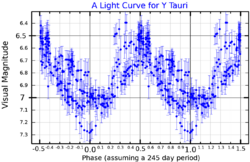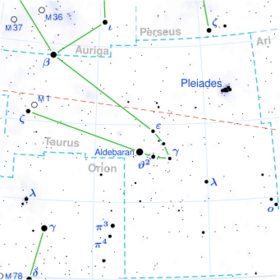Astronomy:Y Tauri
From HandWiki
| Observation data Equinox J2000.0]] (ICRS) | |
|---|---|
| Constellation | Taurus |
| Right ascension | 05h 45m 39.4101s[1] |
| Declination | +20° 41′ 42.149″[1] |
| Apparent magnitude (V) | 6.5 - 9.2[2] |
| Characteristics | |
| Evolutionary stage | AGB[3][4] |
| Spectral type | C6.5,4e(N3)[2] |
| Variable type | SRb[2] |
| Astrometry | |
| Radial velocity (Rv) | 17.00[5] km/s |
| Proper motion (μ) | RA: 0.039[1] mas/yr Dec.: −4.532[1] mas/yr |
| Parallax (π) | 1.5006 ± 0.0592[1] mas |
| Distance | 2,170 ± 90 ly (670 ± 30 pc) |
| Absolute magnitude (MV) | −1.1 (near max.)[6] |
| Details | |
| Mass | 4.3[7] M☉ |
| Radius | 219[8] R☉ |
| Luminosity | 6,025[4] L☉ |
| Surface gravity (log g) | 0.228[7] cgs |
| Temperature | 3,217[9] K |
| Metallicity [Fe/H] | −0.106[7] dex |
| Other designations | |
| Database references | |
| SIMBAD | data |
Y Tauri is a carbon star located in the constellation Taurus. Parallax measurements by Gaia put it at a distance of approximately 2,170 light-years (670 parsecs).[1]

Y Tauri is a semiregular variable star. Its class is SRb, and its primary pulsation cycle lasts 241.5 days.[2] No long secondary period has been identified.[11] It has a radius of 219 R☉, an effective surface temperature of 3,217 K, and a bolometric luminosity of 4,489 L☉. Its mass is calculated to be 4.3 M☉.
Y Tauri is losing mass at 4×10−7 M☉/yr, and is surrounded by dust at a temperature of 1,900 K.[3]
References
- ↑ 1.0 1.1 1.2 1.3 1.4 1.5 Brown, A. G. A. (2021). "Gaia Early Data Release 3: Summary of the contents and survey properties". Astronomy & Astrophysics 649: A1. doi:10.1051/0004-6361/202039657. Bibcode: 2021A&A...649A...1G. Gaia EDR3 record for this source at VizieR.
- ↑ 2.0 2.1 2.2 2.3 Samus, N. N. et al. (2009). "VizieR Online Data Catalog: General Catalogue of Variable Stars (Samus+ 2007-2013)". VizieR On-line Data Catalog: B/GCVS. Originally Published in: 2009yCat....102025S 1. Bibcode: 2009yCat....102025S.
- ↑ 3.0 3.1 Van De Sande, M.; Walsh, C.; Millar, T. J. (2021). "Chemical modelling of dust-gas chemistry within AGB outflows - III. Photoprocessing of the ice and return to the ISM". Monthly Notices of the Royal Astronomical Society 501 (1): 491. doi:10.1093/mnras/staa3689. Bibcode: 2021MNRAS.501..491V.
- ↑ 4.0 4.1 Guandalini, R; Cristallo, S (2013). "Luminosities of carbon-rich asymptotic giant branch stars in the Milky Way". Astronomy & Astrophysics 555: A120. doi:10.1051/0004-6361/201321225. Bibcode: 2013A&A...555A.120G.
- ↑ Gontcharov, G. A. (2006). "Pulkovo Compilation of Radial Velocities for 35 495 Hipparcos stars in a common system". Astronomy Letters 32 (11): 759–771. doi:10.1134/S1063773706110065. Bibcode: 2006AstL...32..759G.
- ↑ Gontcharov, G. A. (October 2011). "The red giant branch in the Tycho-2 catalogue". Astronomy Letters 37 (10): 707–717. doi:10.1134/S1063773711090040. ISSN 1063-7737. Bibcode: 2011AstL...37..707G.
- ↑ 7.0 7.1 7.2 Anders, F. et al. (1 August 2019). "Photo-astrometric distances, extinctions, and astrophysical parameters for Gaia DR2 stars brighter than G = 18". Astronomy and Astrophysics 628: A94. doi:10.1051/0004-6361/201935765. ISSN 0004-6361. Bibcode: 2019A&A...628A..94A.
- ↑ Stassun, Keivan G. et al. (2019-10-01). "The Revised TESS Input Catalog and Candidate Target List". The Astronomical Journal 158 (4): 138. doi:10.3847/1538-3881/ab3467. ISSN 0004-6256. Bibcode: 2019AJ....158..138S.
- ↑ Chandler, Colin Orion; McDonald, Iain; Kane, Stephen R. (2016). "The Catalog of Earth-Like Exoplanet Survey Targets (CELESTA): A Database of Habitable Zones Around Nearby Stars". The Astronomical Journal 151 (3): 59. doi:10.3847/0004-6256/151/3/59. Bibcode: 2016AJ....151...59C.
- ↑ "ASAS All Star Catalogue". The All Sky Automated Survey. http://www.astrouw.edu.pl/asas/?page=aasc.
- ↑ Olivier, E. A.; Wood, P. R. (2003). "On the Origin of Long Secondary Periods in Semiregular Variables". The Astrophysical Journal 584 (2): 1035–1041. doi:10.1086/345715. Bibcode: 2003ApJ...584.1035O.
 |


